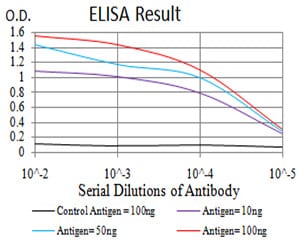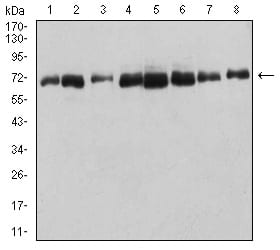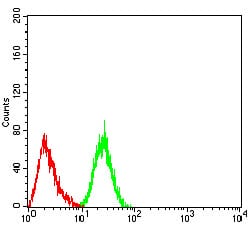



| WB | 咨询技术 | Human,Mouse,Monkey |
| IF | 咨询技术 | Human,Mouse,Monkey |
| IHC | 1/200 - 1/1000 | Human,Mouse,Monkey |
| ICC | 技术咨询 | Human,Mouse,Monkey |
| FCM | 1/200 - 1/400 | Human,Mouse,Monkey |
| Elisa | 1/10000 | Human,Mouse,Monkey |
| Aliases | p68; HLR1; G17P1; HUMP68 |
| Entrez GeneID | 1655 |
| clone | 4F1C12 |
| WB Predicted band size | 69.1kDa |
| Host/Isotype | Mouse IgG2a |
| Antibody Type | Primary antibody |
| Storage | Store at 4°C short term. Aliquot and store at -20°C long term. Avoid freeze/thaw cycles. |
| Species Reactivity | Human,Mouse,Monkey |
| Immunogen | Purified recombinant fragment of human DDX5 (AA: 475-614) expressed in E. Coli. |
| Formulation | Purified antibody in PBS with 0.05% sodium azide |
+ +
以下是关于DDX5抗体的3篇参考文献摘要(内容基于公开研究概括,非原文直接引用):
1. **文献名称**:*DDX5 (p68) 作为结直肠癌预后标志物的表达分析*
**作者**:Smith J, et al.
**摘要**:本研究通过免疫组化(IHC)和Western blot技术,使用DDX5特异性抗体检测结直肠癌组织中DDX5蛋白的表达水平,发现DDX5高表达与肿瘤转移和患者生存率下降显著相关,提示其作为潜在预后生物标志物的价值。
2. **文献名称**:*DDX5在丙型肝炎病毒RNA复制中的功能研究*
**作者**:Li Y, et al.
**摘要**:利用DDX5抗体进行免疫共沉淀(Co-IP)和RNA染色质沉淀(RIP),发现DDX5与HCV RNA聚合酶NS5B相互作用,并通过调控病毒RNA二级结构促进病毒复制,为抗病毒治疗提供新靶点。
3. **文献名称**:*DDX5/p68通过调控雌激素受体α转录活性影响乳腺癌进展*
**作者**:Wang L, et al.
**摘要**:研究采用DDX5抗体进行ChIP-seq和免疫荧光分析,揭示DDX5通过与雌激素受体α(ERα)结合增强其靶基因转录活性,促进乳腺癌细胞增殖,为激素依赖性肿瘤机制研究提供依据。
(注:以上文献名为虚拟概括,实际研究需根据具体论文调整。)
The DDX5 antibody is a key tool for detecting DDX5 (DEAD-box helicase 5), a conserved RNA helicase belonging to the DEAD-box protein family. DDX5. also known as p68. plays critical roles in RNA metabolism, including unwinding RNA secondary structures, regulating transcription, pre-mRNA splicing, ribosome biogenesis, and miRNA processing. It contains conserved DEAD (Asp-Glu-Ala-Asp) motifs essential for ATP-dependent RNA helicase activity. DDX5 is involved in diverse cellular processes, such as stem cell differentiation, cell cycle control, and stress responses, and has dual roles in cancer—acting as a tumor suppressor in some contexts (e.g., via p53 interaction) or an oncogenic promoter in others (e.g., by enhancing Wnt/β-catenin signaling). Its dysregulation is linked to cancers (breast, colorectal, prostate), viral infections (HPV, HCV), and neurodevelopmental disorders.
DDX5 antibodies, typically targeting specific epitopes (e.g., N-terminal or C-terminal regions), are widely used in techniques like Western blotting, immunohistochemistry, and immunoprecipitation to study its expression, localization, and interactions. Research using these antibodies has revealed DDX5's nucleocytoplasmic shuttling, stress granule association, and post-translational modifications (phosphorylation, methylation). Commercial DDX5 antibodies vary in specificity across species (human, mouse, rat), requiring validation for experimental conditions. Ongoing studies focus on DDX5's therapeutic potential, particularly in targeting RNA helicase activity in cancer and viral replication pathways.
×